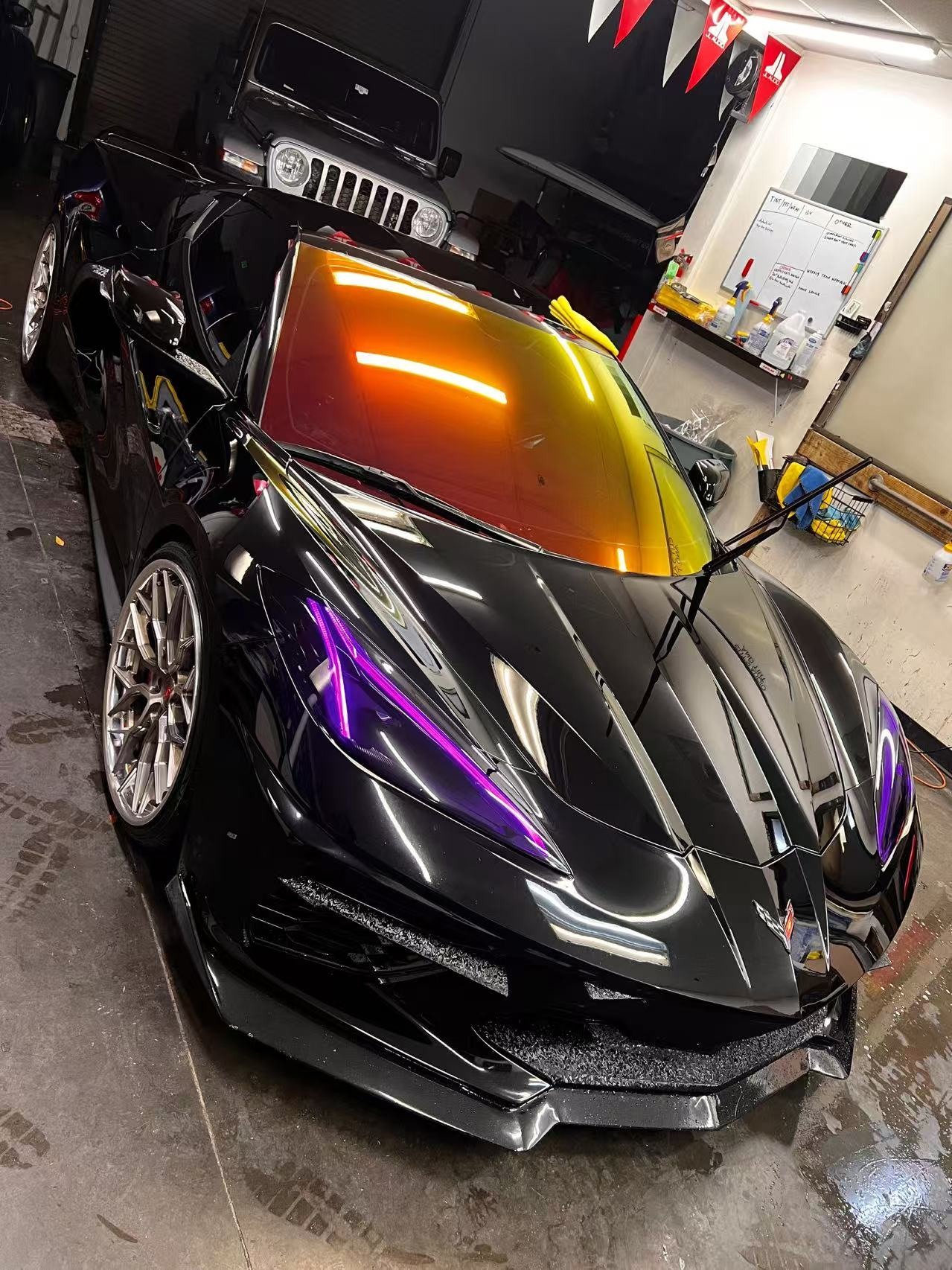Window tinting has become a popular way to improve privacy in various places such as homes, offices, and vehicles. This innovative method involves putting a thin film on windows, which can greatly reduce visibility from the outside while still allowing a clear view from the inside. The appeal of window tinting is its ability to provide privacy without blocking natural light, making it an attractive choice for many.
Have you ever wondered if window tinting really provides the level of privacy you want? This article aims to answer that question by looking at the effectiveness of different types of window films in enhancing privacy both during the day and at night. With many options available on the market, each with its own advantages and disadvantages, it’s important to understand which film best suits your needs.
In this article, we will explore:
- One-way window films
- Blackout/whiteout films
- Other specialized window tints
For example, one-way window films are designed to provide maximum privacy during the day while still letting light in. On the other hand, blackout or whiteout films offer complete concealment from outside view regardless of the time of day.
We will compare these options in terms of how well they provide privacy. Whether you’re looking for daytime concealment or nighttime security, keep reading to find out the best window tinting solution for your specific needs.
Understanding Window Tinting
Window tinting is a flexible solution used in various places—homes, offices, and vehicles—to improve privacy and manage light exposure. By putting special films on windows, you can block the view from outside while still being able to see your surroundings clearly from inside.
How Window Tinting Works
The effectiveness of window tinting lies in its ability to manipulate light transmission through the use of different types of window films. These films are designed to:
Reflect or absorb light
Reduce glare
Enhance privacy
Different films offer varying degrees of opacity and reflectiveness, affecting how much visibility you retain and how much you block.
Types of Window Films
- One-Way Window Films: Create a mirrored effect on the exterior.
- Blackout/Whiteout Films: Block all visibility for total privacy.
- Translucent Films: Allow diffused light while maintaining privacy.
- Dual-Reflective Films: Reflect more light on one side for dynamic privacy solutions.
Applying Window Films: A Step-by-Step Process
Achieving the desired effect with window tinting involves several careful steps:
- Surface Preparation: Clean the glass thoroughly to remove any dust, grime, or fingerprints that might interfere with film adhesion.
- Film Installation:
- Measure and cut the film slightly larger than the window size.
- Apply a soapy water solution to the glass surface to allow easy repositioning.
- Peel away the protective backing from the film and carefully place it onto the wet glass.
- Smoothing Out Bubbles: Use a squeegee to eliminate air bubbles and excess water between the film and glass, working from the center outward.
- Trimming Excess Film: Trim any overhanging edges for a neat finish using a sharp blade.
- Curing Time: Allow the film time to cure properly; this can vary based on environmental conditions but typically ranges from several days to weeks.
Understanding these processes helps ensure that window tinting not only meets your privacy needs but also maintains its aesthetic appeal over time.
The Role of Window Tinting in Privacy Enhancement
Privacy Benefits of Window Tinting
Window tinting is a great way to keep your personal space private while still letting in natural light. Whether it’s your home, office, or car, window tints create a barrier that prevents outsiders from seeing in. This means you can go about your activities without worrying about being watched.
One of the unique features of certain window films, like nano ceramic films, is their ability to maintain visibility from the inside while enhancing privacy on the outside. This means you can enjoy clear views without feeling exposed to prying eyes. It’s this combination of benefits that makes window tinting an appealing choice for those who want both privacy and style.
Factors Affecting Privacy Levels with Window Tinting
When it comes to window tinting, understanding how different lighting conditions affect privacy is crucial. Here are some key factors to consider:
1. Daytime Privacy
During the day when it’s bright outside, darker tints are most effective at providing privacy. The contrast between the bright exterior and dim interior makes it difficult for people outside to see through tinted windows.
2. Nighttime Limitations
However, at night when interior lights are on, the situation changes. Lighter tints may struggle to keep interiors hidden as increased brightness inside can make it easier for outsiders to peek in. This is why many individuals opt for additional measures like curtains or blinds during nighttime hours.
These insights emphasize the importance of thinking about both day and night scenarios when choosing window tinting solutions. By understanding these factors, you can make informed decisions about which type of film will best meet your privacy needs under different conditions.
In summary, while window tinting offers significant privacy benefits during certain times of the day, its effectiveness can be influenced by the interaction between indoor and outdoor lighting. Whether you go for darker or lighter tints will largely depend on your specific requirements and environmental factors. As you explore further options like nano ceramic window tint solutions, you’ll discover additional solutions that can complement your window tinting choices and enhance overall privacy levels around the clock.
Exploring Different Types of Window Films for Enhanced Privacy
One-Way Window Film: A Popular Choice
One-way window film has gained popularity among both homeowners and vehicle owners. This type of film provides excellent daytime privacy without significantly sacrificing visibility. By creating a mirrored effect on the exterior surface, it becomes challenging for individuals outside to see inside, while those indoors can still enjoy an unobstructed view.
Limitations of One-Way Window Film at Night
While one-way window films offer effective privacy during the day, they have notable limitations when it comes to nighttime privacy. Once interior lights are turned on after sunset, the film’s effectiveness diminishes due to the phenomenon known as reverse reflection.
Key Factors Affecting One-Way Window Film Performance
- Daytime Effectiveness: The mirrored effect operates optimally when the outdoor environment is brighter than the indoor space, ensuring that prying eyes remain blocked.
- Nighttime Challenges: At night, when interior lights are brighter than exterior lighting, these films often reverse their effect. Instead of providing concealment, they can inadvertently allow outsiders to see inside.
This duality in performance highlights an essential consideration for those seeking continuous privacy solutions. While one-way films excel in ensuring privacy during daylight hours, they might not suffice alone for complete nighttime discretion.
For settings where consistent privacy 24/7 is crucial, additional measures such as curtains or blinds could be necessary to complement one-way window films. Balancing aesthetics with practical needs ensures that you can maintain desired levels of privacy regardless of the time of day.
Exploring Alternative Options
To overcome the limitations of one-way window films, exploring alternative options such as Chameleon window films could be beneficial. These films not only provide enhanced privacy but also come with color-shifting solutions which can add a unique aesthetic appeal to your windows.
Additionally, considering Nano Ceramic window films could also be advantageous. These films are engineered for superior heat rejection and UV protection while maintaining optical clarity. They provide unmatched performance and durability, making them ideal for both vehicles and buildings.
Another viable option is Nano Carbon window films. These high-performance films are infused with advanced carbon technology which ensures superior heat rejection and optical clarity, making them suitable even for the hottest climates.
For those interested in bulk purchasing or distribution of these premium quality window films, KSB Window Film Material Co., LTD stands out as a top tint film factory and wholesaler in China. They offer a wide range of tint films designed for various needs including privacy enhancement, UV protection, and energy savings.
Other Window Film Options Worth Considering for Privacy Needs
When considering window tinting options for privacy, blackout films and whiteout films stand out as robust alternatives. These films provide complete opacity, effectively blocking visibility in both directions. This makes them ideal for spaces where total privacy is non-negotiable.
Blackout Films
- Advantages:
- Total blockage of light and view, ensuring maximum privacy.
- Useful in environments needing complete darkness, like home theaters or bedrooms.
- Disadvantages:
- Can increase heat absorption due to lack of light penetration.
- May reduce natural lighting significantly, necessitating artificial lighting during the day.
Whiteout Films
- Advantages:
- Offer a clean aesthetic while providing full privacy.
- Capable of reducing glare from external light sources.
- Disadvantages:
- Similar heat absorption issues as blackout films.
Limited visibility can be a downside in areas where some outside view is preferred.
In addition to these, translucent films offer a middle ground by allowing diffused natural light while maintaining privacy. These variations make window tinting a versatile choice for different privacy needs and settings.
Frequently Asked Questions
Does window tinting provide privacy?
Yes, window tinting can provide a level of privacy by acting as a barrier against prying eyes from outside while still allowing natural light to enter. However, the effectiveness of window tinting in providing privacy can vary based on factors such as the type of film used and the lighting conditions.
What are the different types of window films available for privacy enhancement?
There are several types of window films that enhance privacy, including one-way films, blackout films, whiteout films, and translucent films. Each type has its unique characteristics and benefits, catering to different privacy needs and preferences.
How does the lighting condition affect the effectiveness of window tinting?
Lighting conditions play a significant role in the effectiveness of window tints. During the day, darker tints generally offer better privacy when there is more light outside than inside. Conversely, at night, when interior lights are turned on, lighter tints may not provide sufficient concealment from external viewers.
What is one-way window film and how does it work?
One-way window film is a popular choice for those seeking daytime privacy without sacrificing too much visibility. It creates a mirrored effect on the exterior surface, making it difficult for people outside to see in while allowing those inside to enjoy an unobstructed view.
Are there any limitations to using one-way window film at night?
Yes, one-way window films have limitations at night. Once interior lights are turned on after sunset, these films may become less effective at preventing outsiders from peering in due to reverse reflection, which compromises nighttime privacy.
What are blackout and whiteout films?
Blackout and whiteout films are alternative choices that offer complete opacity. Blackout films block all light for maximum privacy, while whiteout films reduce glare but may absorb heat. Each comes with its own set of advantages and disadvantages based on specific needs.






